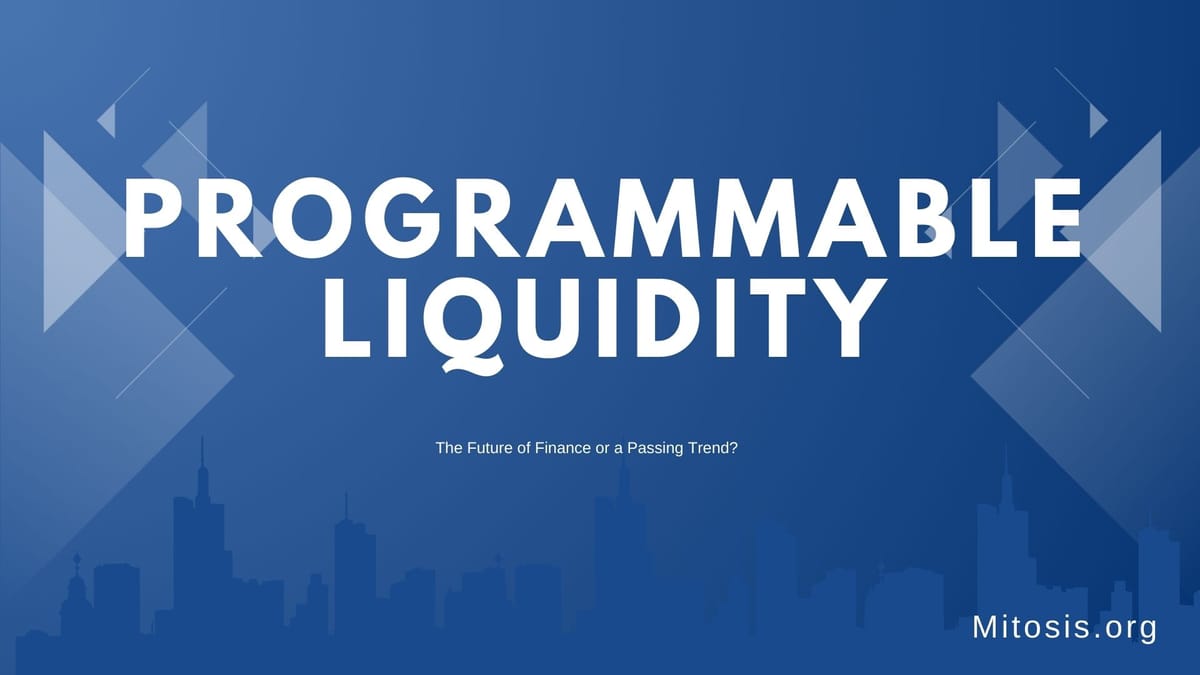PROGRAMMABLE LIQUIDITY: The Future of Finance or a Passing Trend?

INTRODUCTION
Liquidity is the backbone of any financial system — it determines how easily assets can be bought or sold. In traditional finance, managing liquidity involves banks, brokers, and a lot of paperwork. But in decentralized finance (DeFi), liquidity is handled by code.
Why Programmable Liquidity Matters Now
With billions of dollars already flowing through DeFi, the way liquidity is managed can no longer be static. The need for automated, real-time liquidity management is growing — and programmable liquidity answers that need. It’s a response to the demand for smarter, faster, and more reliable financial tools.
In this article, we would explore: What programmable liquidity is and how it works. Real-world use cases and platforms leading the innovation. The benefits, risks, and the big question: is this a lasting revolution or a passing trend?
What Is Programmable Liquidity and How Does It Work?
Programmable liquidity refers to the ability to automate and control the flow of liquidity (i.e., assets like tokens or funds) using smart contracts and decentralized protocols. It's mainly used in DeFi (Decentralized Finance). In simple terms: It means you can set rules for how your tokens are added to or removed from liquidity pools — and let code handle it automatically. Amazing stuff, right?
For example, let's say you want to provide liquidity to a DEX (like Uniswap) only when the price of ETH is above $2,000 and pull it out if it drops below. With programmable liquidity, you can write that logic into a smart contract.
How It Actually Works
Smart Contracts: Act like robot bankers, they execute instructions without needing human input.
Algorithms & Triggers: These are predefined logic like “if price drops 10%, move to stablecoin pool.”
Liquidity Pools: Users deposit assets into these pools, which are then automatically allocated for trading, lending, or yield farming.
Example: If a liquidity provider stakes ETH in a pool, and the yield on another platform spikes, the smart contract can automatically redirect the funds to that higher-yielding platform.
Real-World Use Cases and Platforms
Yield Optimization Protocols:
In this case, users deposit crypto, afterwards, smart contracts shift it to the highest-yielding DeFi platforms automatically, and finally users earn returns without lifting a finger. An example is in Yearn Finance.
Liquidity-as-a-Service
In traditional DeFi models, projects often rely on offering substantial token incentives or liquidity mining rewards to attract and retain liquidity providers. While this approach can be effective in the short term, it often leads to unsustainable token emissions, temporary liquidity, and mercenary capital that exits as soon as rewards diminish. Programmable liquidity offers a smarter, more sustainable alternative.
Instead of needing to overcompensate for liquidity through high rewards, projects can now “rent” programmable liquidity — effectively accessing capital that can be dynamically allocated and redirected based on real-time needs and strategic objectives. This rented liquidity is not bound by the rigidity of traditional pools; rather, it is fluid, controlled via governance or protocol-specific parameters, and can be deployed across various exchanges and platforms as needed. A great example of this concept in action is Tokemak.
Risk Mitigation & Automated Hedging
Monitors market volatility.
If high-risk conditions are detected, smart contracts reallocate funds into safer assets.
Helps users avoid major losses during market crashes. An example is DeHedge.
The Benefits and Challenges Ahead
As programmable liquidity keeps evolving, it's creating a really interesting situation - there are some amazing opportunities on the table, but also some challenges that we need to think about. The way technology, finance, and regulations are all coming together is opening up new possibilities for how liquidity works, how we manage risk, and who can participate in markets. For instance, assets from both ERC-20 and emerging BRC-20 token standards can now interact more fluidly through programmable systems, enhancing composability and expanding the role of the liquidity pool beyond just trading — into automated allocation, hedging, and yield strategies.But at the same time, it's also raising some important questions about what this means for the stability of our financial systems, how efficient our markets are, and how we protect investors. By examining the opportunities and challenges of programmable liquidity, we can gain a deeper understanding of its potential impact on financial markets and the ways in which it may shape the future of finance.
Benefits of Programmable Liquidity
-Efficiency: Liquidity is always optimized, no downtime or manual oversight.
Example: Balancer auto-adjusts token weights in pools to stay balanced.
-Transparency: All movements are on-chain and auditable.
-Decentralization: No middlemen, just trust in code.
-Accessibility: Anyone can use these tools, not just hedge funds or institutions.
Challenges to Watch
-Smart Contract Risk
Example: The 2020 Yam Finance bug led to a $750,000 loss due to a code error.
-Oracle Manipulation
Programmable liquidity often relies on price feeds. If these are compromised, liquidity can be misrouted.
Example: Synthetix lost funds in 2019 due to an oracle bug.
-User Experience
The technology is still complex, with steep learning curves.
Simpler interfaces and better education are needed.
-Regulatory Gray Areas
Governments are still figuring out how to regulate these tools.
Example: SEC scrutiny of DeFi lending platforms could affect programmable liquidity systems too.
Here are a few things you might want to note:
-Programmable liquidity uses smart contracts to dynamically manage funds across DeFi protocols. -It’s already being used for yield optimization, cross-chain swaps, liquidity renting, and risk hedging. -While challenges exist, such as security and regulatory clarity, the benefits point toward long-term adoption.
CONCLUSION
Programmable liquidity is far more than just another fleeting DeFi experiment — it represents a transformative and strategic upgrade in the way we manage, deploy, and optimize capital within decentralized ecosystems. By leveraging smart contracts and automated protocols, programmable liquidity introduces a level of efficiency, transparency, and flexibility that traditional financial systems are fundamentally incapable of achieving. It empowers protocols and users alike to tailor liquidity flows according to real-time market conditions, governance parameters, and custom strategies — all without the need for intermediaries. This includes innovations such as cross-chain liquidity, where assets can flow seamlessly across multiple blockchains, and fair market liquidity, ensuring that pricing and availability remain efficient and unbiased across platforms. This automation not only reduces operational overhead and risks associated with centralized control but also ensures that capital is allocated and utilized in the most efficient way possible.
If current trends continue, programmable liquidity could become a core infrastructure layer for decentralized finance and even traditional financial institutions. Like the shift from paper money to digital payments, this evolution may seem slow at first — until it becomes the new standard.


Comments ()